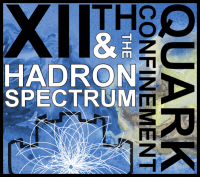Speaker
Description
Report at the Session: Future Perspectives, Upgrades, Instrumentation
Vertex detector for open charm measurements with NA61/SHINE at SPS at CERN
G.A.Feofilov $^1$$^†$ (for NA61/SHINE Collaboration)
(1) Saint-Petersburg State University
$^†$ E-mail: feofilov@hiex.phys.spbu.ru
Search for the critical point of strongly interacting matter and studies of the onset of deconfinement are in the focus of the current NA61/SHINE experimental programme. The last one is being conducted by means of investigation of fluctuations and system size dependences of various observables in hadron collisions energy scan at the SPS at CERN. Quite new and enhanced physics capabilities are opening after completion of the ongoing modernization of the NA61 / SHINE installation, when the total rate of statistics will be increased more than 10 times, thus allowing the study of open charm in Pb-Pb collisions at the SPS energies. It is expected that studies of rare processes of heavy flavors production (first of all, of particles containing charm quarks) and their interaction with the medium produced in such collisions - will allow us to get new information about the physical processes in the area of the hypothethical critical point of nuclear matter. These studies could help also to discriminate existing theoretical models relevant to the initial stages of hadron collisions, evolution of quark-gluon plasma, matter induced changes in the yields of quarkonia, energy loss mechanisms, …etc.
In this report we present a physics motivation followed by the brief status of the ongoing development of the dedicated Vertex Detector (VD) designed for open charm measurements in Pb-Pb collisions with the NA61/SHINE at CERN SPS. The task is quite challenging in view of very low yields at the threshold region of open charm production. It is being solved for the NA61/SHINE by the application of the coordinate sensitive Si-sensor chips in CMOS technology for the high precision tracking to the to the vertices of hadronic decays. This precise tracking is done by a set of four Si-sensor planes in combination with the particle identification by the NA61/SHINE TPSs. The extremely low material budget of the VD (below 0.3 % X/Xo for each tracking plane) is achieved by the implementation of proven ALICE technologies of the extra-lightweight thermo- and mechanically stable structures for Si-detectors cooling and support. After completion of the VD, due to its high spatial tracking resolution and low multiple scattering contributin, it will be possible to apply geometrical selections and to separate the D-mesons decay vertex from the interaction one.
The author of this report acknowledges the support by the Russian Science Foundation research grant 16-12-10176.
Summary
Report at the Session: Future Perspectives, Upgrades, Instrumentation
Vertex detector for open charm measurements with NA61/SHINE at SPS at CERN
G.A.Feofilov $^1$$^†$ (for NA61/SHINE Collaboration)
(1) Saint-Petersburg State University
$^†$ E-mail: feofilov@hiex.phys.spbu.ru
In this report we present a physics motivation followed by the brief status of the ongoing development of the dedicated Vertex Detector (VD) designed for open charm measurements in Pb-Pb collisions with the NA61/SHINE at CERN SPS. The task is quite challenging in view of very low yields at the threshold region of open charm production. It is being solved for the NA61/SHINE by the application of the coordinate sensitive Si-sensor chips in CMOS technology for the high precision tracking to the to the vertices of hadronic decays. This precise tracking is done by a set of four Si-sensor planes in combination with the particle identification by the NA61/SHINE TPSs. The extremely low material budget of the VD (below 0.3 % X/Xo for each tracking plane) is achieved by the implementation of proven ALICE technologies of the extra-lightweight thermo- and mechanically stable structures for Si-detectors cooling and support. After completion of the VD, due to its high spatial tracking resolution and low multiple scattering contribution, it will be possible to apply geometrical selections and to separate the D-mesons decay vertex from the interaction one.
The author of this report acknowledges the support by the Russian Science Foundation research grant 16-12-10176.
